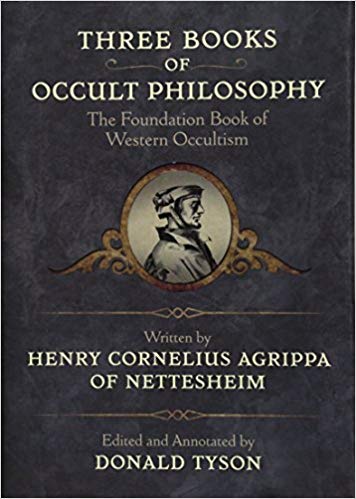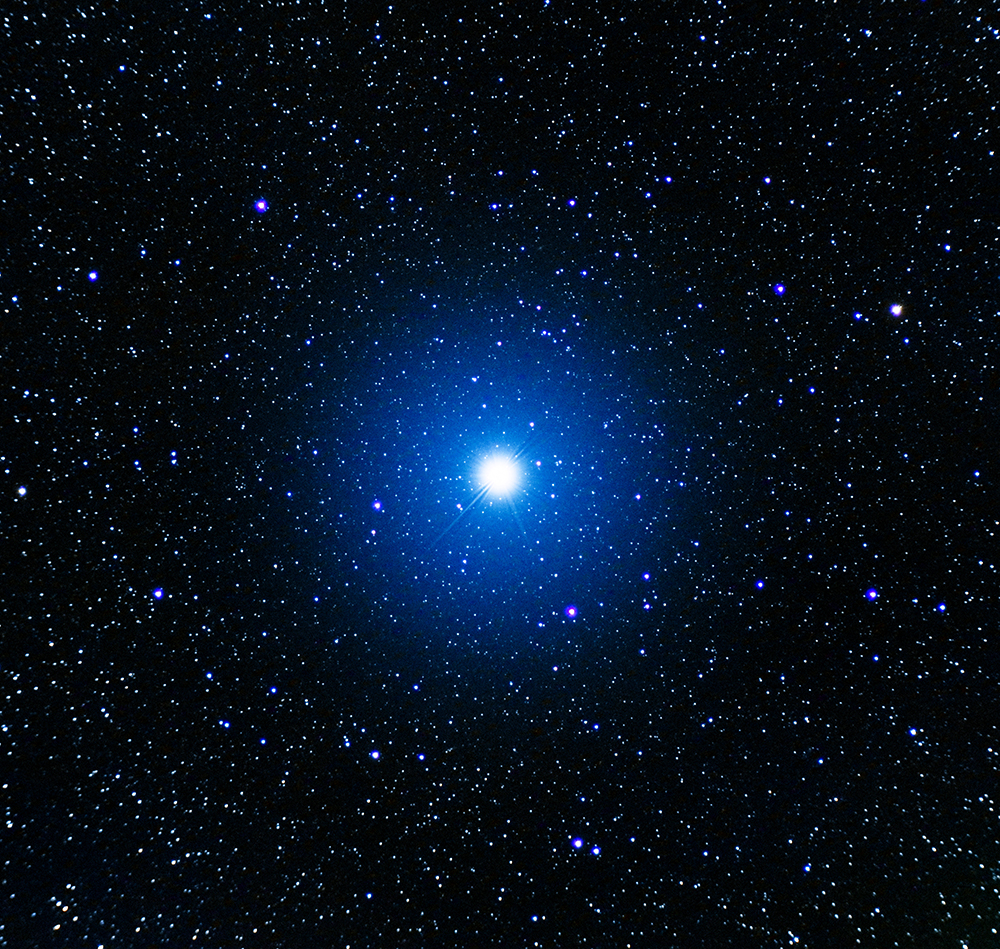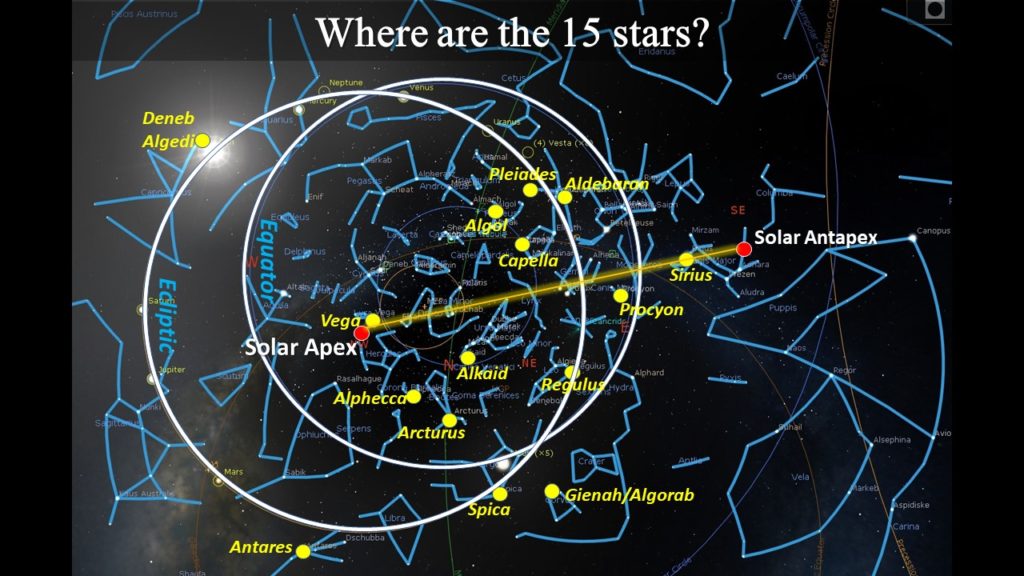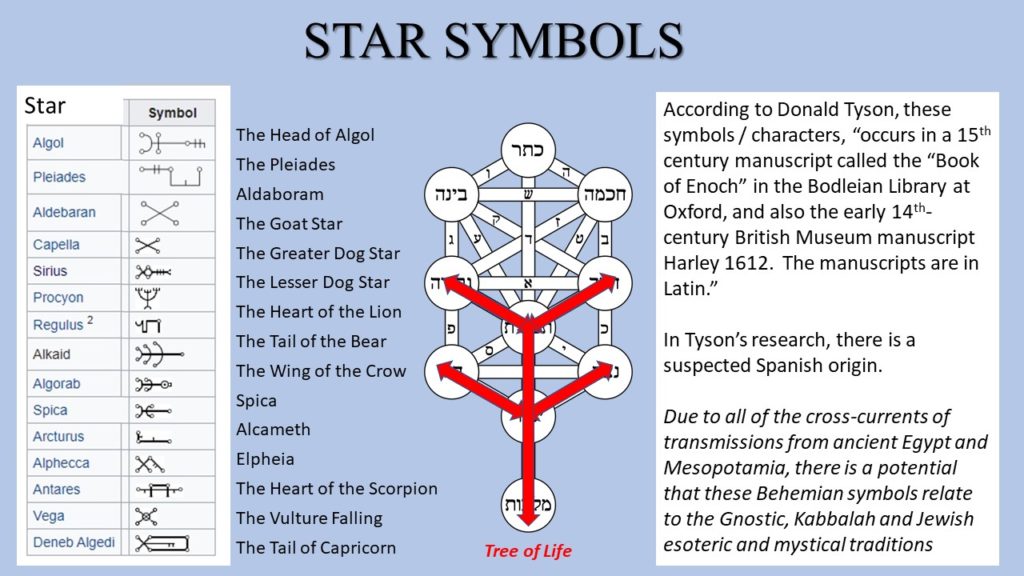As an astrologer, I have been inspired recently to take a further dive into a greater understanding of the stars known in the Middle Ages and Renaissance period as the Behenian Stars, a group of 15 stars that were studied for their magical properties. My inquiry into these stars was to see how they fit into astrology and Daniel Giamario’s shamanic astrology paradigm.
Since 2011, shamanic astrologer Cayelin Castell has been sharing the magical qualities of these Behenian stars in various classes and webinars in her Venus Alchemy courses and at the Shamanic Astrology Mystery School. Cayelin’s sharing left me with questions about where and how these stars were singled out in the distant past as well as the differences with the four Persian Royal stars, amongst other star groupings.
It was only recently when I was looking to do a novel presentation at an upcoming event in Arizona that I decided upon the Behenian Stars.
What we know of these stars comes directly from the Three Books of Occult Philosophy by Henry Cornelius Agrippa, published in the 1530s. My resource of that was an edited and annotated version from Donald Tyson (hardcover edition) in 2019. This version has been very helpful in understanding who Agrippa was and his intentions about the book.
It is likely that the details of the Behenian Stars came from the thrice-great Hermes Trismegistus’ writings. Though another source from Sir Wallis Budge suspects an ancient Sumerian origin. I believe that both could be true.
The word, “Behenian” is from “Behen”, from the Arabic, “bahman”. According to Donald Tyson, “The old herbalists adopted it without knowing its attribution, so it was never clearly fixed. Agrippa uses the term as a synonym for Arabian.”
Cayelin Castell’s research led her to Agrippa’s work and how “behen” or “bahman” is a kind of “root”. “Therefore, the Behenian stars were considered a source or “root” of astrological power that was magnified whenever one or more of the visible planets were within six degrees.” Clifford Hartleigh Low writes, “these were the Behenian Stars; behen being the distortion of an Arabic word for “root.”
If we source the Behenian stars from Hermes Trismagistus, as most have done, then the original reference writings are not entirely known. But there have been powerful spiritual and philosophical writing known to have come from Trismagistus, including that famous, “as above, so below . . .” verse from the Emerald Tablets.
What are these 15 stars? All of them are easily visible, relatively-speaking, to the naked eye, with some of them being the brightest in the sky. But it is known that certain other bright stars, like Fomalhaut and Canopus, Betelgeuse and Rigel were left out of the group for unknown reasons. However, for the purposes of this article, I will place more emphasis of what is included than what was not included.
Here is the list of the 15 Behenian stars (in order of how they are presented in Agrippa’s books):
The locations listed are as of March, 2020
Algol – in Perseus 26°27’ Taurus
Pleiades Star Cluster – in the Bull 29°40’ Taurus to 0°40’ Gemini
Aldebaran – in the Bull 10°04’ Gemini
Capella – in Auriga 22°09’ Gemini
Sirius – Canis Major 14°22’ Cancer
Procyon – Canis Minor 26°04 Cancer
Regulus – in the Lion 0°07’ Virgo
Alkaid – Great Bear 27°13’ Virgo
Algorab – Corvus/Crow 13°44’ Libra
Spica – in the Priestess 24°08’ Libra
Arcturus – Bootes 24°31’ Libra
Alphecca – Corona Borealis 12°35’ Scorpio
Antares – in the Scorpion 10°03’ Sagittarius
Vega – Lyra/Falling Vulture 15°36’ Capricorn
Deneb Algedi – in the Goat-Fish 23°50’ Aquarius
Each of the stars are also associated with planets, gemstones, symbols and herbs. From this, we can see that these stars were used in various magical workings, including for healing, creating change and divination.
Here is a breakdown of the stars and their symbols
Several of these stars are very well known:
- Pleiades
- Aldebaran
- Capella
- Regulus
- Spica
- Arcturus
- Sirius
- Antares
- Vega
As this is an article, I won’t go into great detail about each of these Behenian stars, I will highlight a few famous ones. In the future, I could do a series of articles and/or webinar series about all of the 15 stars.
Sirius
Sirius , the brightest star in our sky after the Sun, was on the ecliptic 100,000 years ago (Procyon was on the ecliptic 51,000 years ago) as modern humans were only beginning to spread across the planet. This star sits in our local stellar neighborhood at a distance of 8.6 light years from Earth.
Sirius was known as Sopdet thousands of years ago in ancient Egypt, playing a powerful role in the life of the Egyptian culture. The star was a central part in understanding the Nile River and its seasonal gift of flooding. It represented the goddess Hathor or Isis (depending upon the area of Egypt).
The Egyptians referred to the heliacal rising of Sirius and its associated festival as prt spdt, “the going forth of Sopdet.” (Holberg page 9)
A calendar based upon Sirius and known by the ancient Greeks as the “Sothic Cycle” (Sothis is the Greek name for Sirius) equaled 365 days. After 1,461 Sothic Cycles, the calendar returns back in line with the civic calendar (1,460 years).
There is also a relationship between Sirius and the mythic bird, Phoenix. The story is that centuries or millennia, the Phoenix flies west to build a funeral pyre at the temple of Heliopolis in Egypt, then is consumed by the fires. Phoenix is then re-birthed from the fire’s ashes, where it flies east to repeat the cycle. This points to a relationship between Sirius and the Sun and the 1,461 Sothic Cycles.
Agrippa writes, “Under the Greater Dog Star, they made the image of a hound and a little virgin; it bestoweth honour and good will, and the favor of men and arial spirits, and giveth power to pacify and reconcile kings, princes and other men.” Pg 395
Today, Sirius is known as the “dog-star” and its canine imagery goes back to ancient Europe and we can think of the “dog days” of summer in part, due to this star and its bright presence in the Canis Major constellation. It rises as a morning star in mid-to-late summer in the Northern Hemisphere.
Vega
The traditional name Vega (earlier Wega) comes from a loose transliteration of the Arabic word wāqi‘ meaning “falling” or “landing”, via the phrase an-nasr al-wāqi‘, “the falling eagle“.
Vega is part of the Lyra constellation and that constellation’s transmission as Orpheus string instrument from the body of a turtle (created by Hermes/Mercury). The connection to a string instrument comes from the Greco-Roman traditions.
Vega and its constellation is also known as a vulture or other bird diving or falling from ancient Egypt and Mesopotamia.
Agrippa refers to Vega as a “Falling Vulture”. Assuming his knowledge of the Behemian stars comes from Hermes, then the avian imagery of Vega and the constellation its part of goes back many thousands of years. Agrippa writes, “Under the Vulture, they made the image of a vulture or hen, or of a traveler; it maketh a man magnanimous, and proud; it giveth power over devils and beasts.” Pg 396
Ancient Chinese and Japanese culture were inspired by the star Vega and they each have a story centered about the star Vega in relationship with Altair – aka the Weaver Girl and the Cowherd with references to the Sky King. In that time, the Japanese called Vega Orihime and celebrate a festival in July / August called Tanabata. The date the Tanabata festival is celebrated is “movable” due to its origin being on a lunisolar calendar (held on the 7th day of the 7th lunar month).
The story of the Weaver Girl and the Cowherd have some resonances with the Mesopotamian saga story of Dumuzi and Inanna.
Arcturus
This star has a very long history of viewing from ancient cultures throughout the globe. The name of Arcturus came long before the constellation name in which it resides, called Bootes, the Bear Driver.
The Persians referred to it as the leg of the Lance-Bearer. In India, it marked the 13th Lunar Station and known as the “Good Goer” or “sword.” Arcturus has a relationship with the bright star, Spica (nearby). Both of these stars were at one time known as the calves of the lion. Spica being the “first calf” and Arcturus being the “second calf.” In the night sky, one can see the constellation of The Lion (or Leo in astronomical terms) chased by the Priestess constellation below and to the right of Bootes (where Arcturus resides).
Arcturus is also known for having a relative “speedy” proper motion, meaning, it tends to move in the sky faster than other stars and relative to the other stars in the sky. It is also noted in modern history that the light of Arcturus activated a mechanism to turn on the power at the 1933 Chicago World’s Fair. Currently, it has a powerful connection to the star Spica as they reside at the same astrological degree of 24 Libra. Arcturus is higher in the sky in the Northern latitudes with Spica glued to the ecliptic in the Priestess constellation.
In Agrippa’s words, “Alchameth, they made the image of a horse or wolf, or the figure of a man dancing; it is good against fevers, it astringeth and retaineth the blood.” Page 395
The Stars of the Sphere
During Agrippa’s time and into the 17th century, there was a burgeoning interest in astrology and many astrologers would publish their divinations and other findings as the printing became more readily available, especially in the 17th century. Many were looking for answers to plagues, marriages, royal happenings, wars and other major events and so astrologers were in the soup of all the drama in Europe. Astrology was used more in a “predictive” way, but some astrologers allowed for free will to guide a person in their life’s journey and in astrologer William Lilly’s case, the heavens “did not compel”.
As Cayelin Castell wrote, the Behenian stars and really, any major star, was used only when it was relatively close to a planetary position (including the Sun and Moon). They considered six degrees to be the orb of connection to a planet and the closer it was the more impactful the star’s influence in the planet’s expression on an astrology chart.
On that note, for those not very familiar with astrology, the sky in its relationship to Earth, is divided into 12 segments of 30 degrees each, making a complete 360 degrees of a sphere/circle. Using the Whole Sign House system that I use, the 12 signs of the zodiac (not the constellations) each represent 30 degrees of the circle. The signs are tied to Earth’s seasonal energy (determined by the back and forth tilt and orbit of Earth around the Sun).
The zodiac is a band of stars constellations roughly centered on the ecliptic, or path the Sun “travels” across the sky each year. These are the stars chiefly associated with astrology and in particular, what we know as western astrology and can serve as navigational markers and bring their own symbolic language and mystery to the astrological signs. Along the ecliptic, starting with the March equinox point (Vernal equinox), 360 degrees are counted off toward the June Solstice point, then September equinox and December Solstice, going back to the March equinox, encompassing the Earthen sphere, including north and south from the ecliptic.
Each star is located at a certain degree in the sky sphere projected out from the Earth which means that each Behemian star is in a certain place in the sphere. If we take a look at the placement of each of the stars we may or may not find a pattern with it.
Navigating the Behenian Stars
Only 2 of the 15 stars are 10 degrees or more “south” or “below” the ecliptic. All the rest of them are near the ecliptic or in the northern polar constellations. Since roughly 90% of the human population lives north of the equator and most of those between 20 and 40 degrees north latitude, it is easy to see the perception of the northern stars primarily featured. Though his actual origin remains a mystery, it is known with a certain level of reasoning that, Hermes Trismagistus, credited with the sharing about these stars, lived and/or worked in two of the world civilizations cradles in Mesopotamian and Egyptian regions.
Since the majority of Trismagistus’ writings have been not been uncovered/found, we don’t know the point of origin of these Behenian stars and why these 15 stars were chosen. We can only pick up the pieces of what Agrippa wrote and others have commented upon and researched. There is also looking at the 15 stars, all visible in the Northern Hemisphere. There are very few authors and researchers who have even referenced the Behenian stars. Usually, when any of these stars are discussed in astrology, astronomy or mythology works, no mention of the word, “Behenian” is mentioned.
Each of these 15 stars is associated with a Kabbalistic symbol that points to a more ancient origin with a resonance with the Tree of Life that is worked with in the more mystical and esoteric sect of Judaism, whose origins can be traced back to ancient Egypt and the Mesopotamia regions many thousands of years ago. My theory of these stars is that to fully understand them lies within the Kabbalistic symbols associated with each of them. The symbols could have some connection to the mythology around the concept of the World Tree in the sky, currently represented by the north star Polaris, but was represented by other stars over many thousands of years, including Vega 13,000 years ago.
The symbols could also loosely connect to a spatial map of sorts for the night sky in the manner the dots and lines are oriented, which is not discussed in Tree of Life materials out there. One clue stems from the locations of the Solar Apex and the Solar Antapex, which are the directions the Solar System is moving toward and away from, respectively.
Two of the Behenian stars loosely mark the Solar Apex and Antapex. According to astronomer and EarthSky writer Bruce McClure, Vega, the brightest star in the constellation Lyra the Harp, marks the general direction of the solar apex – the direction in which the Sun is traveling through space. Sirius, the Dog Star, the brightest in the nighttime sky, shows you the general direction of the solar antapex – the direction that the Sun is traveling from. Vega lies about 25 light-years distant from Earth, and Sirius looms about 9 light-years away. These two stars are only about 34 light-years from one another.
http://www.idialstars.com/tspm.htm – More details about the movement of the Sun in the galaxy from Bruce McClure.
If one were to trace a line from the Solar Apex to Solar Antapex, the line would fall only a few degrees away from the star Polaris. The line falls a bit below Polaris but through Draco the Dragon constellation and the nose/mouth of Ursa Major, the Great Bear. But taking into account that the Earth is a sphere and we are looking at the sky dome, the line would curve and maybe come closer to the pole star. Regardless, this is an interesting synchronicity and connection to the World Tree, which is talked of at great length in the books, Hamlet’s Mill and When the Dragon Wore the Crown.
While we don’t have any records our ancient ancestors knew about the Solar Apex and Solar Antapex, we can’t necessarily rule it out of hand and further discoveries could uncover more interesting speculation.
Vega and Sirius mark the southernmost and northernmost stars and so form a boundary of sorts to this group of 15 stars. With the knowledge of the Solar Antapex and Apex, we can associate them as keepers of the north and south with all the other stars serving other roles and navigational markers in the Northern Hemisphere.
Using the Behenian stars in Shamanic Astrology
As Cayelin Castell wrote, a person can make use of stellar closeness when any of those stars are within six degrees of an astrological point on a chart. This would be especially valuable when looking a person’s Ascendant or Rising Sign (including the Descendant, Home & Roots and Midheaven), but could also be used with other personal points such as the Moon, Sun, Mars, Venus Mercury, Jupiter or the two lunar nodes.
For example, a person born with their Ascendant within six degrees of the star Regulus (24 degrees Leo to 6 degrees Virgo) is infused with the heartbeat of the Sky Lion, a constellation that has had powerful influence in lion deities and iconography in ancient Egypt and elsewhere. Specifically, there is a strong resemblance of the Lion Constellation to the ancient Sphinx and how 11,000 years ago the constellation marked the March Equinox with Regulus being the alpha star carrying the symbolic characteristics of the constellation.
Regulus has the distinction of being one of the four Royal Stars from ancient Persia (along with Fomalhaut or Altair, Antares and Aldebaran. Later, this had strong influence in the Christian Bible as stars and constellations they inhabited were the four Cherubic forms (Lion, Bull, Man and Eagle if Altair is considered) according to William Tyler Olcott in his book, Star Lore (page 234).
In 2011, Regulus moved into the sign of Virgo for the first time in 26,000 years, which astrologer Dane Rudhyar points out as one of the markers for the so-called “Age of Aquarius.”
Regulus adds an element of the creatrix and vibrational inspiration to the example of having the Ascendant within six degrees of it. It is a pillar of the sky sits nearly exact on the path of the Sun (ecliptic).
Another example is the star, Deneb Algedi in the Goat-Fish constellation at 23°50’ Aquarius. This star is not as bright as Regulus or the other stars shared about, but does play an important role in connecting the Earth to Water. The form of the Goat-Fish, being half goat in the head and front legs with the back morphing into scales and a tail. It is the first constellation that takes an observer to the “watery” part of the sky.
This constellational image of the Goat-Fish first appeared about 2100 BC (from researcher and astronomer Greg Crossen) in ancient Sumarian works. This is the first known record of it, but it may have been a much, much older image.
The Goat-Fish was originally a “Goat-Carp”, which is known as the “The Magur Boat”, a type of boat (with a Goat’s Head) with a highly raised stern and prow. When looking at the constellation, it bears the ‘wedge-like’ shape as the Magur river boat. This boat was sacred to the god Enki (aka Saturn/Kronos) as were the symbols of the Goat and Fish.
Deneb Algedi marks the tail of the Goat-Fish and the transmission to with the sea/ocean of the cosmos where infinite knowledge resides. A person can add the qualities shared here if one of their personal planets or points is within six degrees of Deneb Algedi. The range would be about 17 degrees to about 29 degrees Aquarius.
Agrippa writes, “Under the Tail of Capricorn they made the image of an hart, or goat or of an angry man; it bestoweth prosperity and increaseth wrath.” Page 396.
In the interpretations of these stars from Agrippa and others from middle ages and Renaissance period, there was a certain judgment (good or bad) placed upon the stars and planets and their positions. As one can see, it was no different for the Behenian stars. Some of that judgment comes from Ptolemy in the Tetrabiblos and various translations from ancient languages
In other applications, a person can create ceremony around the rise or setting or culmination of these stars or even when a transiting planet (or Moon/Sun) crosses the area of a particular star. This could be done with an intent to create a personal inquiry into one’s own life and a seeking of guidance. Ceremony can be personal or in groups and typically involves creating a sacred and safe space to honor one’s self and/or a celestial moment, including its connection to a holiday or even an anniversary.
It also encourages a full participation in one’s life cycles and the timings in life. The stars and planets, as the 17th century English astrologer, William Lilly, points out, “do not compel”. This means we have free will in our choices during any planetary/celestial initiation or transit.
The Behenian stars are stars that have been shared as magical but it is really al stars and planets have their own magic and can be utilized through symbolic, psychic, spiritual and otherwise magical purposes in our lives. The near-infinite sky dome is a part of our lives and has been since our very distant ancestors hundreds of thousands of years looked upon them and not only wondered what they were but also from a place of seeking, of finding meaning and seeing something beyond themselves.
“Know thyself,” is a foundational spiritual tenant and the stars are part of that journey toward knowing thyself and astrology is one of the more powerful tools (among others) a person can employ to do that. But the journey to knowing thyself doesn’t truly end in static, unchanging truth. The wheels continue to spin and cosmos unfolds before us, whether or not we are paying attention.





This if a great article. It will take me a while to read it and assimilate the information. What a great tool for understand one’s own Path in this life. Thank you so much for your work and wisdom. You are a shining star amidst the stars.
Thank you for being my mentor.
Emma
Thank you, Emma! I am of service in this realm.
This was definitely an interesting artical there is alot to understand and explore thank you for sharing so much of your work.
Kathleen
Thank you, Kathleen! I love to share about all of this. More to come, for sure!!
Erik
Wow, this was great Erik. It really inspires me to know more! I have two on my Mercury, and one each conjunct my Mars, MC all within 3 degrees so I will be especially interested in any future commentary you have! Personally, if they came from the book of Enoch, then they must come from the origins of astrology which I believe to be PRE- Sumerian in origins. This is exciting to me and I look forward to any more work you do with these.
Since I have time on my hands with social distancing and must stay at home during these times of Coronavirus, I can read your article again and assimilate more! This is a good time to write and research. Thanks for your insightful work!
Dixie
Thank you, Dixie! That is great that you have some personal points connected to these stars. I’ve been finding it more and more valuable to explore this area of astrology. I do believe the knowledge of these stars is very ancient and potentially before some of the oldest cuniform writing. I’ll be writing more in the future and creating videos. But this stellium in Capricorn is really both unnerving and a strange wonderment of experience.
thank you Erik for your article, research and sharing. It does feel very magical and is calling me although my mind is struggling to understand. I will reread and do further exploring.
thanks
Karen
Thank you, Karen! I loved researching about these stars. There will certainly be more to come as further exploration continues.
Erik